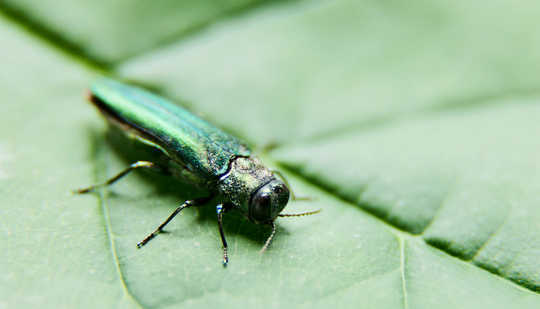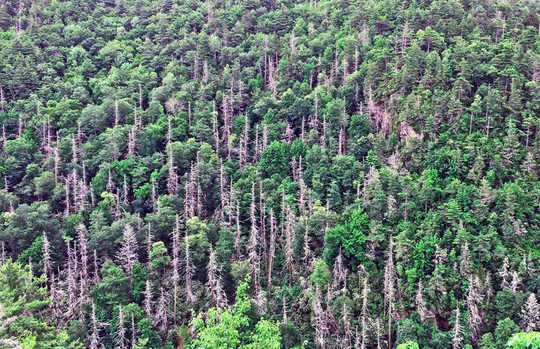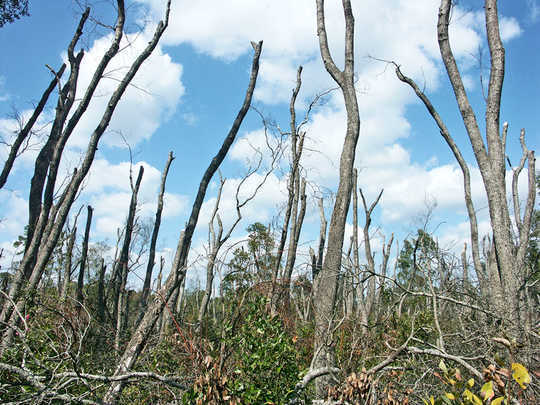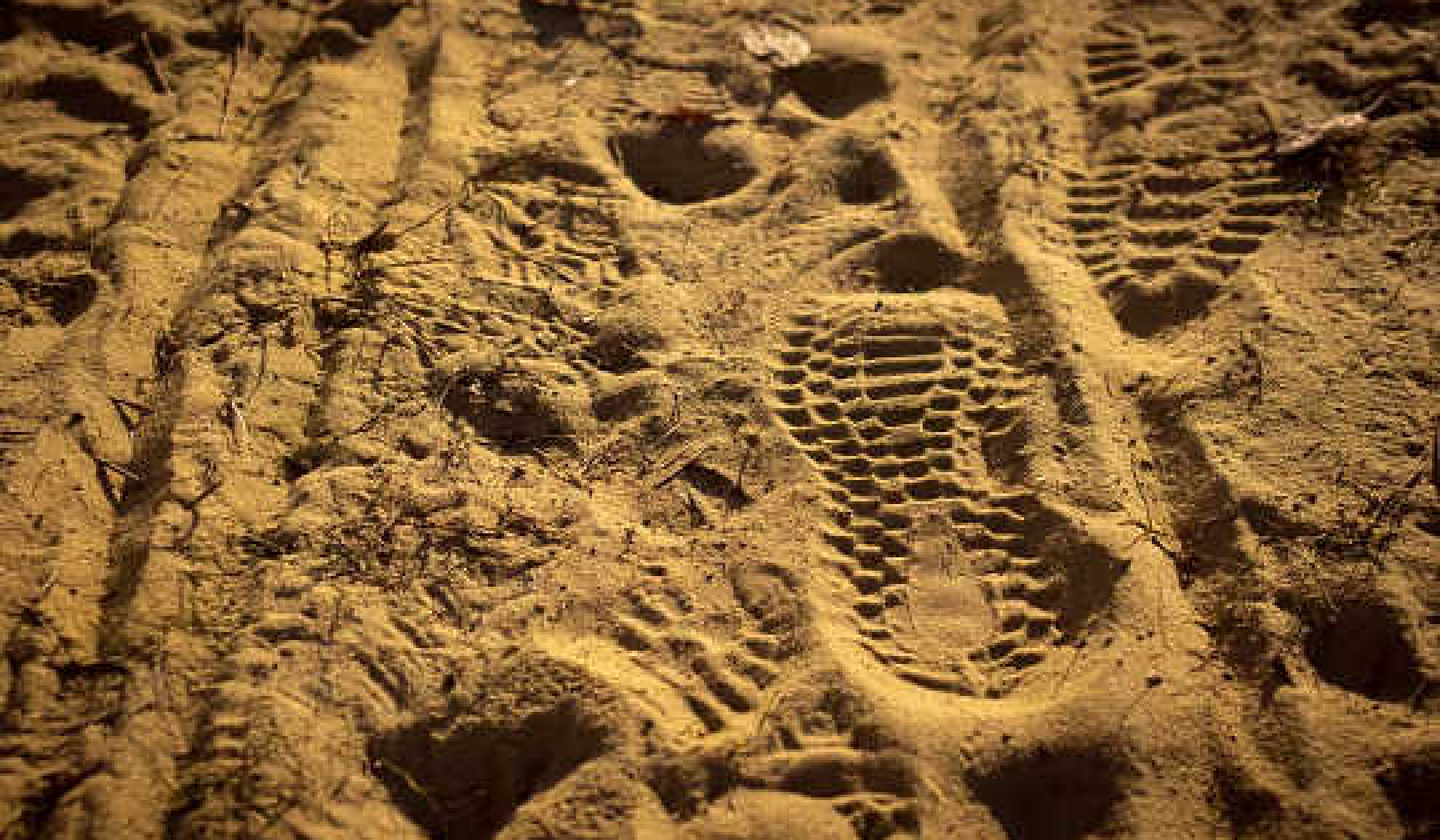
The emerald ash borer. (Credit: Chesapeake Bay Program/Flickr)
In addition to the ecological impact, the devastation invasive pests wreak on trees reduces carbon storage equivalent to the amount of carbon emitted by 5 million vehicles each year.
Invasive insects and pathogens have wreaked havoc on ash, elm, chestnut, and other trees, wiping some almost completely from American forests.
The trees the 15 most invasive pests kill each year contain 5.53 teragrams of carbon (TgC), equivalent to about 6 million US tons.
“Not all of those dead trees immediately become carbon sources, but they are being taken away from the live biomass, which functions as carbon sink. Part of the dead biomass will eventually get into the atmosphere,” says Songlin Fei, a professor in the forestry and natural resources department at Purdue University.
 In Great Smoky National Park in North Carolina, the hemlock woolly adelgid decimates hemlock trees. (Credit: Songlin Fei)
In Great Smoky National Park in North Carolina, the hemlock woolly adelgid decimates hemlock trees. (Credit: Songlin Fei)
Losing the fight
The losses are especially concerning as some have suggested that forest carbon sequestration might fight climate change by capturing and retaining more of the carbon from the atmosphere. Losses due to invasive species could damage those hopes, Fei says.
“If we are thinking of forests as a tool to mitigate climate change, the tool itself is being challenged by these invasive pests. Not only is the tool damaged, but also it’s becoming an impediment.”
As reported in the Proceedings of the National Academy of Sciences, researchers analyzed 10 years of forest surveys covering 93,000 field plots in the contiguous United States. They measured tree loss due to invasive pests—above and beyond natural tree deaths—for the most harmful pathogens and insects the Forest Service tracks.
 In Evans County Georgia, laurel wilt disease has destroyed a stand of redbay laurel trees. (Credit: Kevin Potter)
In Evans County Georgia, laurel wilt disease has destroyed a stand of redbay laurel trees. (Credit: Kevin Potter)
Of the 15 invasive pests in the study, nine are pathogens, four are sap-feeders, one is a wood-borer, and one is a foliage-feeder. The most damaging pests, in terms of biomass loss apart from expected natural losses, include the emerald ash borer, Dutch elm disease, beech bark disease, and hemlock woolly adelgid.
The most damaging species for mortality rate, as measured in percent of the biomass loss, were laurel wilt disease (11.4%), chestnut blight (6.3%), and butternut canker (5%).
A growing problem?
While the current annual loss from invasives is only 0.04% of the total live biomass in the contiguous US, the problem could grow, the researchers say. Of the 15 pests, three have only invaded about half of their potential range and seven have invaded less than 35%.
“While the total biomass losses reported here are only a relatively a small percentage of the total biomass, it is important to emphasize that the trajectory of future impacts of these pests can be anticipated to increase, as most of the damaging pests analyzed here have not invaded the full ranges of their hosts,” the authors write.
“Given the continued range expansion of existing pests and the anticipated establishment of new nonnative pests in the future, proactive policies aimed at mitigating future invasions are likely to yield secondary benefits of reducing greenhouse gas emissions.”
The researchers also caution that their estimates are certainly low because they did not include losses from urban areas. They have also not included hundreds of other pests that inhibit tree growth and development of root systems that can hold significant amounts of carbon.
The researchers plan to work on determining the amount of the carbon from dying trees that returns to the atmosphere and the amount that soil captures. The National Science Foundation and the USDA funded this work.
Source: Purdue University
Related Books
Life After Carbon: The Next Global Transformation of Cities
by Peter Plastrik , John Cleveland The future of our cities is not what it used to be. The modern-city model that took hold globally in the twentieth century has outlived its usefulness. It cannot solve the problems it helped to create—especially global warming. Fortunately, a new model for urban development is emerging in cities to aggressively tackle the realities of climate change. It transforms the way cities design and use physical space, generate economic wealth, consume and dispose of resources, exploit and sustain the natural ecosystems, and prepare for the future. Available On Amazon
The future of our cities is not what it used to be. The modern-city model that took hold globally in the twentieth century has outlived its usefulness. It cannot solve the problems it helped to create—especially global warming. Fortunately, a new model for urban development is emerging in cities to aggressively tackle the realities of climate change. It transforms the way cities design and use physical space, generate economic wealth, consume and dispose of resources, exploit and sustain the natural ecosystems, and prepare for the future. Available On Amazon
The Sixth Extinction: An Unnatural History
by Elizabeth Kolbert Over the last half-billion years, there have been Five mass extinctions, when the diversity of life on earth suddenly and dramatically contracted. Scientists around the world are currently monitoring the sixth extinction, predicted to be the most devastating extinction event since the asteroid impact that wiped out the dinosaurs. This time around, the cataclysm is us. In prose that is at once frank, entertaining, and deeply informed, New Yorker writer Elizabeth Kolbert tells us why and how human beings have altered life on the planet in a way no species has before. Interweaving research in half a dozen disciplines, descriptions of the fascinating species that have already been lost, and the history of extinction as a concept, Kolbert provides a moving and comprehensive account of the disappearances occurring before our very eyes. She shows that the sixth extinction is likely to be mankind's most lasting legacy, compelling us to rethink the fundamental question of what it means to be human. Available On Amazon
Over the last half-billion years, there have been Five mass extinctions, when the diversity of life on earth suddenly and dramatically contracted. Scientists around the world are currently monitoring the sixth extinction, predicted to be the most devastating extinction event since the asteroid impact that wiped out the dinosaurs. This time around, the cataclysm is us. In prose that is at once frank, entertaining, and deeply informed, New Yorker writer Elizabeth Kolbert tells us why and how human beings have altered life on the planet in a way no species has before. Interweaving research in half a dozen disciplines, descriptions of the fascinating species that have already been lost, and the history of extinction as a concept, Kolbert provides a moving and comprehensive account of the disappearances occurring before our very eyes. She shows that the sixth extinction is likely to be mankind's most lasting legacy, compelling us to rethink the fundamental question of what it means to be human. Available On Amazon
Climate Wars: The Fight for Survival as the World Overheats
by Gwynne Dyer Waves of climate refugees. Dozens of failed states. All-out war. From one of the world’s great geopolitical analysts comes a terrifying glimpse of the strategic realities of the near future, when climate change drives the world’s powers towards the cut-throat politics of survival. Prescient and unflinching, Climate Wars will be one of the most important books of the coming years. Read it and find out what we’re heading for. Available On Amazon
Waves of climate refugees. Dozens of failed states. All-out war. From one of the world’s great geopolitical analysts comes a terrifying glimpse of the strategic realities of the near future, when climate change drives the world’s powers towards the cut-throat politics of survival. Prescient and unflinching, Climate Wars will be one of the most important books of the coming years. Read it and find out what we’re heading for. Available On Amazon
From The Publisher:
Purchases on Amazon go to defray the cost of bringing you InnerSelf.comelf.com, MightyNatural.com, and ClimateImpactNews.com at no cost and without advertisers that track your browsing habits. Even if you click on a link but don't buy these selected products, anything else you buy in that same visit on Amazon pays us a small commission. There is no additional cost to you, so please contribute to the effort. You can also use this link to use to Amazon at any time so you can help support our efforts.























